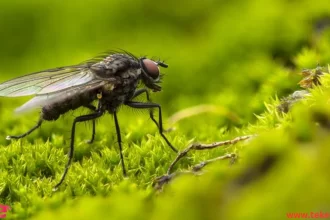It belongs to the genus Loxosceles and the species reclusa.
Its scientific name is Loxosceles reclusa.
The Brown Recluse Spider prefers to live in warm, dry areas such as abandoned buildings, woodpiles, and storage areas.
Let’s learn more about it from teketrek.
Many facts about the Brown Recluse spider
It is brown in color and is a venomous spider.
When a human is bitten by a Brown Recluse Spider, their skin turns red and the affected area swells a few hours after the bite.
The most distinctive feature of the Brown Recluse Spider is a violin-shaped mark on the head region.
The dark brown neck of the violin points towards the abdomen.
To differentiate between male and female Brown Recluse Spiders, their reproductive organs need to be examined under a high-powered microscope.
The Brown Recluse Spider uses its short fangs to inject venom into its prey’s body.
When provoked, this spider bites and its venom causes necrotic wounds to humans.
Despite the potency of the venom injected by the Brown Recluse Spider, it is extremely shy and spends daylight hours in seclusion.
This limits its exposure to predation by other animals.
The Brown Recluse Spider spins irregular webs in all directions and uses its venom to immobilize insect prey.

The Brown Recluse Spider specification
The measures: The Brown Recluse Spider measures about three-eighths of an inch in length and has a width of about three to sixteen inches.
The color: the Brown Recluse Spider is uniformly light brown in color with no spots, bands, or contrasting colored threads on its body.
The eyes: The Brown Recluse Spider has six eyes arranged in a semi-circular shape in three pairs. This characteristic distinguishes the Brown Recluse Spider from other spiders, as most other spiders have eight eyes.
The hair: The Brown Recluse Spider lacks hard spines on its body but is covered in soft hair.
Where do brown recluse spiders live?
The presence of the Brown Recluse Spider is limited to the United States in the Midwest and south to the Gulf of Mexico.
The Brown Recluse Spider prefers dark, undisturbed areas with low humidity. In homes, they can be found in basements, attics, and garages.
During the day, the Brown Recluse Spider hides in cardboard boxes, folded clothes, or shoes.
Brown Recluse Spiders have also been found under tree bark, in woodpiles, as well as in wood and solid rocks.
Brown Recluse Spider’s Diet
The Brown Recluse Spider is primarily a scavenger, feeding on dead insects it finds.
It also kills live prey when necessary.
The Brown Recluse Spider is considered a nocturnal animal, searching for food at night.
This is because the night is safer for it.
Reproduction stages of the Brown Recluse Spider
The Brown Recluse Spider lives for about two years.
The female lays around 50 eggs at a time, wrapping them in a silken sac. The egg-laying season occurs between May and July.
A single female Brown Recluse Spider lays eggs five times within a year. When the spiderlings hatch from the eggs, they stay with the mother in her web until they molt several times.
During the first year of life, spiderlings molt up to seven times before reaching adulthood.
Brown Recluse Spider Bite
The Brown Recluse Spider has a venomous bite.
Anyone bitten should seek immediate emergency medical assistance.
Like most spiders, the Brown Recluse Spider usually only bites when provoked.
Accidental threats may occur if the spider is caught in bedding or clothing. People react differently to bites.
Treatment for Brown Recluse Spider Bite
When exposed to a Brown Recluse Spider bite, the affected area should be washed with soap and water, then an ice pack wrapped in a towel should be applied to the area for ten minutes, repeating this process several times.
Key Steps to Identify the Brown Recluse Spider
Look at the spider’s color, which is entirely light brown and has no additional markings.
Examine the violin shape present on the head of the Brown Recluse Spider.
Note the number of eyes; the Brown Recluse Spider has six eyes, not eight like other spiders.
Look for the soft hair that distinguishes the body of the Brown Recluse Spider and the absence of hard spines on it.
Check the size of the Brown Recluse Spider, as its width does not exceed 1.3 cm.

FAQs about brown recluse spider
- How harmful is a brown recluse?
Brown recluse spider bites usually cause localized skin symptoms but can sometimes lead to systemic effects and, in rare cases, death.
- What will happen if you get bitten by a brown recluse spider?
Survival from a brown recluse bite is possible, though it is important to seek medical attention immediately. While fatalities are rare, prompt treatment is crucial as bites can cause significant illness.
- How long does it take for a brown recluse bite to worsen?
The signs and symptoms of a brown recluse bite can develop slowly, often taking up to 12 hours to become noticeable.
- What kills brown recluse spiders?
Effective pesticides for controlling brown recluse spiders include cyfluthrin, bifenthrin, deltamethrin, and lambda-cyhalothrin.
- Do brown recluse spiders have predators?
In the wild, brown recluse spiders face predation from wolf spiders, crickets, praying mantises, robins, wrens, chickens, spider wasps, and centipedes.
- How rare are brown recluse spiders?
Brown recluse spiders are extremely rare outside their known geographic range.
Is the brown recluse spider poisonous?
Yes, the brown recluse spider is poisonous.
In conclusion, it is important to be aware of this type of spider, as its venom can cause swelling and redness in the area it injects its venom, whether in humans or animals. We hope we have provided you with useful and valuable information and amazing facts to help you learn more about the Brown Recluse Spider.
References:





